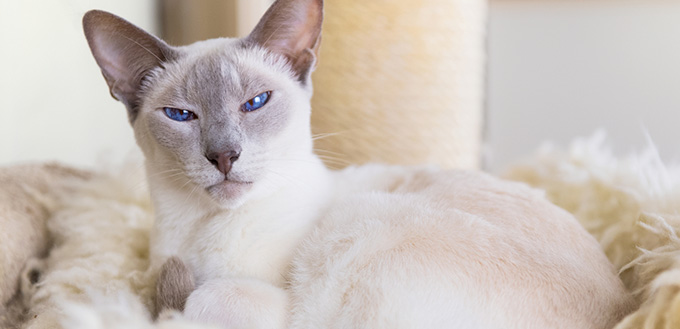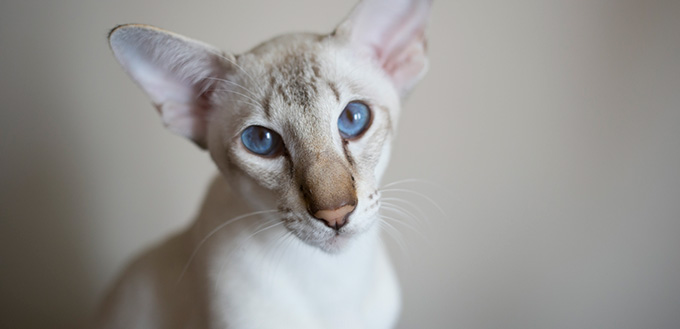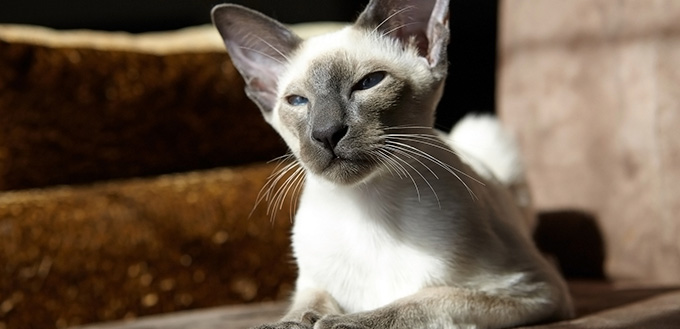Depending on who you are, when you think ‘Java’, you may think about coffee, computer programming, the country of Indonesia, or an intelligent cat. All these different, and potentially misguided, associations with the island of Java can cause a lot of confusion, and, perhaps, the most confusing one of them all is the Javanese Cat. In this article, we will help to answer all the questions you may have about this beautiful cat, such as ‘what is the Javanese Cat like as a pet?’, ‘how should you take care of it?’, and ‘why on earth is it associated to the island of Java?’.

History of the Javanese Cat
The history of the Javanese cat is not straightforward. You are probably assuming that it is a breed that originated from the island of Java in Indonesia, but you would be wrong. There are many cat breeds that have confusing names, or names that wrongly imply where they came from, and one of the most famous is the Javanese Cat.
Rather than being named after the island of Java, it is named in relation to its similar cousin the Balinese. Although it is not certain who first coined the name, it is thought it was first named by a cat breeder, Helen Smith, and her thought process was that, as the two cats look so similar, they should be named thematically. As the island of Java is the closest island to the island of Bali, it made sense to name this new breed the ‘Javanese Cat’.
Even more strangely, the Balinese Cat also has no relation to Indonesia. Both the Javanese and Balinese Cat are descendants of the Siamese Cat, making them distantly Thai in origin. However, as they were both the result of breeding programs in the West, it is, probably, most accurate to refer to them as modern Western breeds. Many cats with ties to East Asia are named in similar traditions.
To understand the Javanese Cat, it is helpful to understand the general background of the Balinese Cat. Although the specific characteristics of the Balinese, and the Siamese, have changed across their almost 200 year history in the US, the Balinese is distinguished from the Siamese as it is a long-haired breed. This trait was a recessive trait within the first Siamese that came to the US and it was carefully encouraged, creating the Balinese.
The Javanese Cat was created in the middle of the 20th Century, about a hundred years since the Siamese cat first came to the US, as an experiment to create a wider color variety of the Balinese. The first Javanese Cats were born from the parents of a Balinese and a Colorpoint Shorthair. It would then take over a decade for the Javanese to gain acceptance as their own breed. In 1979, their coloration was accepted, but only for registration. It would take another 7 years for the Javanese to gain full championship status in the Cat Fanciers Association.
It is true that there is not much difference between the Balinese and Javanese cat. Many cat lovers will not be able to tell the difference between them. Their body shape, coat and personality are very similar. In more recent years, this has resulted in the Javanese Cat being merged with the Balinese Cat as one breed. The two now compete within the same category, and are considered different colorations of the same breed.
Quick Facts About the Javanese Cat
- The Javanese Cat can, generally, be distinguished by its long hair and bright blue eyes.
- Its coat comes in a wide variety, including seal, red, cream and tortoiseshell.
- Since 2008, the Javanese Cat has been considered a sub-breed of the Balinese by the Cat Fanciers Association.
- Other cat associations do not recognize the Javanese at all, and, instead, consider it a variety of Colorpoint Shorthair.
- The simplest way to understand the official definition of the Javanese Cat is as a Balinese cat that does not have the official coloration or pattern of the Balinese.
- The Javanese Cat has nothing to do with the island of Java. It was bred in the US and is descendant from the Siamese Cat, which comes from Thailand.
- Although sometimes considered a long-haired or semi-long-haired cat, despite being a descendant of the Colorpoint Shorthair, the Javanese Cat has a very manageable coat. This has earned them the nickname the ‘lazy man’s longhair’.
- This cat has a wide variety of personality, and it is often thought that their personality is closely linked to the coloration. However, this is unconfirmed.
- Across all colorations, this cat is very intelligent. This will mean you need to dedicate time to their mental stimulation and provide challenging toys for them.
Related Posts: Best Cat Toys and Best Laser Pointers for Cats

Things You Should Know About the Javanese Cat
It is one thing to understand the overly-complicated history of the Siamese, Balinese, and Javanese Cats, but it is a much more important priority to know how to look after your Javanese Cat. Knowing the genetic links between these three breeds can help seasoned cat parents to care for a Javanese because they may be able to see similarities across the breeds, or may already be familiar with potential health concerns shared by the breeds. However, regardless of your experience as a cat parent, it is always helpful to have a guide highlight the most important things you need to know about your cat.
Health
The most important influence of the Javanese Cat’s history is on its health. Unfortunately, the Siamese Cat, and therefore the Balinese Cat and Javanese Cat, have a number of health issues that they are genetically predisposed to. This does not mean your Javanese Cat is definitively going to suffer from these health issues but is useful to know about them to allow for preventative care, where possible, and early diagnosis. The Javanese Cat has links to these health issues:
- Endocardial Fibroelastosis
Endocardial Fibroelastosis is best understood as a congenital heart defect. It occurs when the lining of the heart is excessively thick. This can reduce the effectiveness of their circulatory system and may shorten their lifespans. Affected cats are born with this defect, so watch out if your Javanese kitten or cat appears to frequently suffer from shortness of breath, heart palpitations, abnormal heart rhythms, and any other weaknesses related to breathing or the heart.
- Protrusion of the cranial sternum
While this protrusion in the chest region is known to be very common in many oriental breeds, luckily, this is not actually a dangerous health issue, as long as it protrudes outwards. Inward protrusions can create breathing issues as it can damage the lungs. If your Java Cat has breathing difficulties and you have concerns about the shape of their chest area, it is worth taking them to your vet for a diagnosis.
- Early-onset arthritis, hip dysplasia, and other joint issues
Javanese cats are very strong cats. However, their long-lean bodies and their love of jumping can impact their joints faster than some other breeds. You can help prevent this by reducing the stress on their joints that is caused by obesity, but many joint issues are genetic and are less preventable. Get your vet to check your Javanese Cat’s joints during their annual check-up, and look out for any symptoms of joint pain, such as limping, irritability and a reduction in activity or appetite.
- Cancer
Siamese Cats, and therefore Javanese Cats, are also slightly more prone to certain cancers, or having cancer from an earlier age. Specifically, lymphoma, in which your cat suffers from having abnormal white blood cells, is most common. However, it is very treatable when caught early. The most common lymphoma in Siamese cats is thymoma, which occurs in the chest. Your vet can provide a yearly blood test as part of their check-up, and you should also watch out for weight loss and swollen glands.
Don’t be too scared or worried about your Java Cat. It is not certain that they will struggle with any of these health issues. However, the best thing you can do is to bring them to the vet for very regular checkups. These checkups should be at least once per year, and you may want to schedule additional checkups if you notice any specific symptoms, particularly if they are related to any of the above issues. While it is usually the case that nothing is wrong, it is always worth getting a professional opinion.
Feeding
Luckily, feeding a Javanese Cat is not generally a complicated affair. They do not tend to need special diets and are not known to be fussy eaters. However, individual cats of any breed can be quite fussy, depending on their personality!
If you are an experienced cat parent, you can feed your Javanese Cat just as you have been feeding your other breeds, but if you need a reminder of good, general feeding practices, here is our advice:
- Use high-quality cat food that lists a source of protein as one of the first ingredients
- Avoid cat foods with fillers, such as grains
- Avoid cat foods with preservatives
- Provide approximately 30 calories of food per pound that the cat weighs
- Their treats should only provide them with approximately 10% of their total daily calorific intake
Check out our guide on the Best Wet Foods for Cats for more info.
It is particularly important to be strict with Javanese Cats because they are prone to having gluttonous personalities. They may bug you to feed them more, or to give them more treats. You will have to be quite strict and do your best not to indulge their cute whines and pleading. Obesity is an awful health problem for all animals, and it will result in serious health issues as they grow older.
Related Posts: Best Cat Food for Weight Loss
Care
You may think that your Javanese Cat requires a lot of care because they are fragile. This misconception occurs because of their graceful, long frame, which can appear vulnerable. While it is very true that this breed can suffer from joint issues later in life, this does not make them weak. They are athletic and strong cats that will want a lot of exercise, play, and, in particular, jumping.
Their incredibly muscular body demands a lot of activity, particularly if you do occasionally accidentally indulge their naturally gluttonous personalities. There are two key aspects of exercise that all Javanese Cat owners must know: play and climbing.
Like all active cats, daily playtime is essential to their well-being. Without it, the cat can suffer physically and psychologically as they can grow obese and depressed. As the Java Cat is an intelligent breed, you will need to provide two distinct types of toys. Puzzle toys are more cerebral and will stimulate your cat’s mind, while active toys will tire your cat out and give them the important physical exercise they need.
- Puzzle and interactive cat toys most often come in the form of puzzle feeders, but there is a huge variety for you to try out. Aim to provide as much variety as you can.
- Physical toys can be remote controlled toy mice, string toys, feather toys, or any other number of toys that your cat will enjoy chasing. Remember, you must supervise your cat if the toy has any small, choke-able parts.
Javanese Cats will also naturally exercise through climbing. It seems to be an innate aspect of their personality that they love to climb. This means a Javanese Cat will really enjoy being given climbing towers to play on, but it also means you must be particularly diligent about cat proofing your home.
You May Also Like: Cat Scratching Towers
When they jump, they really stretch out, so you may be surprised just how easy it is for them to get onto even the tallest furniture. This means you cannot rely on keeping dangerous items, like glass, knives and poisonous cleaning fluids, simply out of reach. They must inside cupboards. It also means you must ensure all your furniture is safely secured in order to avoid accidents and huge messes for you to clear up.
Grooming
One of the best things about having a Javanese Cat is that they are quite low maintenance, despite having fairly long hair. While other long-haired breeds require daily brushing, you only need to brush your Java Cat once or twice per week with a stainless steel comb. Remember that you can make this experience easier by rewarding your feline with cat treats during and after the process. This will teach them that grooming is a pleasant, bonding experience. Be slow and careful to avoid snagging hair and hurting them.
You should also clear their eyes and ears once a week, just like with any other breed. All it takes is a soft, damp cloth and a gentle wipe, and you’re done! Last, but not least, you must brush your Javanese Cats teeth at least once a week. As dental disease is a serious health concern for all cats, many professionals recommend daily brushing, if your cat is not too resistant. You must use cat toothbrushes and cat toothpaste, as human equipment can harm your cat’s mouth and human toothpaste is toxic to cats.
Try to make all your grooming practices as pleasant as possible for your Java Cat, as this will allow you to do it more often, which will keep their coat, eyes, ears and teeth healthier. You can offer them treats, and talk to them in soothing tones. Remember to be gentle. It is also a good opportunity for you to give them a health check. Look for any bumps, wounds, discharge, or redness. Take them to a vet if you see anything that concerns you.

Temperament
There is a rumor that the Java Cat’s personality varies with its coat coloration. However, this may not be true. What is certain, however, is that Javanese Cats are vocal, loyal, intelligent and gluttonous. They make fantastic pets for active households, but you must be prepared for a bit of noise and plenty of jumping.
Javanese Cats communicate well and often. If you are late giving them dinner, if they want to play, or if they are just bored, believe us – you will hear about it. Many owners also swear that they not only vocalize often, but understand their owners well, so if you like chatting to your cat, the Javanese is a great breed for you. They are also quite loyal and clingy, so you will never feel lonely with this chatting, doting pet.
It’s intelligence also makes the Javanese Cat a fantastic cat if you want to start training. You may be able to train your Java to come when you call its name, to give you a high-five, and can even try some slightly more complex tricks. What is more, the Javanese Cat will really enjoy this kind of mental and physical stimulation. It is a great opportunity to bond and exercise together.
Training and playing is particularly important for Javanese Cats because they are also quite greedy. They are known to overeat, and you must be quite strict with their portion control. It is not a good idea to allow a Javanese Cat to graze on a constant supply of food throughout the day as they will grow obese. If you think they are likely to succeed in manipulating you into giving them one treat too many, make sure you create an active, healthy lifestyle full of play, toys and training.
Sources:
- Javanese, PetMD
- Javanese Cat Breed – Facts and Personality Traits, Hill’s Pet







